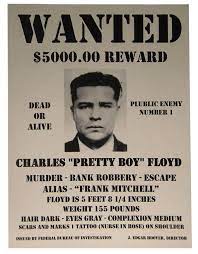1904 The birth of Pretty Boy Floyd

Depression-era America was a period in which its criminal element were figures of great public interest. The restrictions of Prohibition and the hardships of the Dirty Thirties helped persuade many law-abiding citizens that the nation’s outlaw class were latter-day Robin Hoods or at least celebrities worth reading about. The names of John Dillinger, Machine Gun Kelly, Baby Face Nelson, Bonnie and Clyde, and Ma Barker were on the lips of school children, reporters, politicians, and furious police officials.
One of the most famed of the banditti was Charles Arthur Floyd, aka “Pretty Boy”, fabled in literature, film, and song. Listen to his tale as recounted by Woody Guthrie:
Well gather round me children, a story I will tell
About pretty boy Floyd the outlaw, Oklahoma knew him well.
It was in the town of Shawnee on a Saturday afternoon
His wife beside him in the wagon as into town they rode.
Then along came the deputy sheriff in a manner rather rude
Using vulgar words of language, his wife she overheard.
Then pretty boy grabbed a long chain and the deputy grabbed a gun
And in the fight that followed he laid that deputy down.
Then he ran to the trees and bushes to live a life of shame
Every crime in Oklahoma was added to his name.
He ran to the trees and bushes on the Canadian river shore
And many a starving farmer opened up his door.
It was in Oklahoma City, it was on a Christmas day
A whole carload of groceries with a letter that did say:
You say that I’m an outlaw, you say that I’m a thief
Well here’s a Christmas dinner for the families on relief.
As through this life you travel you meet some funny men.
Some will rob you with a six-gun and some with a fountain pen.
As through this life you ramble, as through this life you roam
You’ll never see an outlaw take a family from their home.
There is a lot of poetic anti-capitalist license in Guthrie’s version of events. Rather than being forced into a life of crime, Floyd was already a thief and convict by the time he was 21. After his release from prison in 1929 he turned his hand to bank robbing. Despite the killings that often marked his passage, he acquired a reputation as a friend of the common man. Tales spread of his destroying mortgage documentation in banks and giving money to poor farmers, but there is little hard proof of this. What can be proven is a series of murders and thefts in Oklahoma, Missouri, and Ohio.
In June 1933 “the Kansas City Massacre” made the headlines; four policemen and a prisoner were killed in a botched rescue attempt – Floyd was named as a suspect but he publicly denied his involvement. By now local and federal authorities were turning up the pressure on the brigands. Machine Gun Kelly was caught, Bonnie and Clyde and John Dillinger had been gunned down, vaulting Floyd to the top of the Most Wanted List. In October 1934, after a car crash Floyd was cornered in a farmer’s field and shot to death. Baby Face Nelson was killed within weeks and Ma Barker was shot a few months later. The age of the rural outlaws had ended.